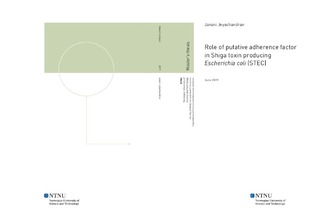| dc.description.abstract | Background: Infection with Shiga toxin producing Escherichia coli (STEC) may cause severe disease like haemorrhagic uremic syndrome (HUS). In addition to Shiga toxins, the ability to adhere to intestinal epithelial cells is important for STEC to cause severe disease. Such adherence is mostly due to intimate attachment mediated by the eae encoded intimin. However, other adhesins may also play a role in adhesion. This master´s project was part of a project designed to study the role of the putative fimbrial operon lpfB1 in adhesion and HUS. The aim of this project was to knockout the eae gene in a clinical STEC strain using the CRISPR/Cas9 editing tool.
Methods: We selected a STEC strain from a HUS outbreak, FHI11, which harboured both the eae gene and the lpfB1 operon but had lost its stx genes. The experiments were done according to a two-plasmid CRISPR/Cas9 protocol for E. coli, with some modifications. The cas9 gene was located on a pCas9 plasmid, and the guide DNA (gDNA) was located on a pCRISPR plasmid. A gDNA was designed to guide the Cas9 to insert a double strand break (DSB) at a specific location in the eae gene. Two alternative repair DNA templates were designed to introduce a specific deletion at the DSB with a premature stop codon to knockout the eae gene. One of these should give a deletion of 201 bp and the other a deletion of 33 bp.
Results: The pCRISPR plasmid containing the gRNA (pCRISPR_T30RNA) was successfully constructed and the assembly was confirmed by PCR and Sanger sequencing. The pCRISPR_T30RNA plasmid and the repair DNA template was then successfully transformed by electroporation into the STEC strain FHI11 harbouring the pCas9 plasmid. Transformants selected using kanamycin and chloramphenicol were then analysed by colony PCR. In the mutagenesis experiment targeted to delete 201 bp, only two colonies found to have an intact eae gene were recovered. In contrast, in the mutagenesis experiment targeted to delete 33 bp, 30 colonies were recovered. However, all but two of these had an intact eae gene. The two remaining colonies might have undergone a larger deletion than expected. Due to time limitation further analyses of the strains from these two colonies were not performed.
Conclusion: The most likely reason that we did not succeed in introducing the specific mutation in the STEC strain to knockout the eae gene is that the homologous directed repair mechanism was not as efficient as expected. Further optimization of the method is therefore necessary. | |
